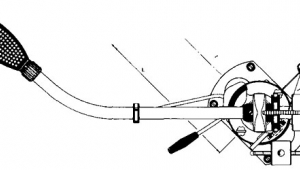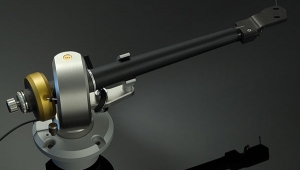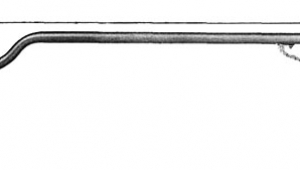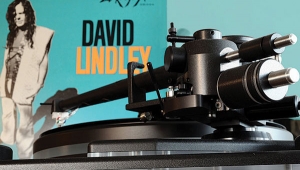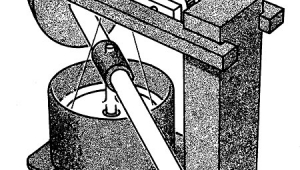| Columns Retired Columns & Blogs |
VPI JMW Classic 3D 12" tonearm

In 1995, Harry Weisfeld's son Jonathan was killed in an automobile accident. Jonathan was a charismatic young man whom I had come to know—a genuinely gifted artist and musician who, at the time of his death, was helping his father develop the tonearm that would be named for him: the JMW Memorial Arm. The design of the original JMW Memorial Arm focused on providing easily adjustable and repeatable VTA and SRA via a massive threaded tower that bolted to the plinth. The bearing point, on the other hand, sat near the end of a relatively long and not particularly rigid metal platform cantilevered off the VTA/SRA tower.
During VPI's ongoing refinements of the JMW arm following Jonathan' passing, fellow Stereophile reviewer Bob Reina visited, to listen to the JMW Memorial in a three-way shoot-out with two other unipivot arms: the Graham Engineering 2.2 and the Immedia RPM. The Immedia easily ran away with the prize, Bob bought one, and uses it to this day. I set up his retipped Koetsu Urushi cartridge a few years ago, and his RPM2 still sounds great; the ingenuity of its design is still impressive.
The Immedia's designer, Allen Perkins, concentrated on producing an efficient and direct vibrational path to ground from arm to plinth by tightly bolting to the armboard the threaded bearing-cup support rod that's first adjusted so that the pivot point is in the plane of the stylus and groove. Another bolt containing the bearing point is screwed from above into the arm pivot's massive housing, to sit in the cup. While adjusting the upper threaded bolt up or down changes the vertical tracking angle (VTA) and stylus rake angle (SRA), the point and cup themselves don't move, which means that the pivot point remains, at all times, in the stylus/groove plane of play. The benefits of this should be obvious, particularly when playing warped records.
All three unipivot designs (Graham, Immedia, VPI) were kept stable with mass that lowered each arm's center of gravity below the pivot point—much as a tightrope walker uses a long, heavy balance pole. The Immedia had a flared pivot housing in the shape of a bell. The Graham used a pair of weights attached to threaded rods placed low on the bearing housing. The JMW used a heavy, asymmetrically weighted, rotatable metal ring isolated with an O-ring.
On the original Immedia arm, azimuth was set by rotating an asymmetrically attached counterweight. Later, this was replaced by a decoupled counterweight assembly, to which was attached a perpendicular threaded rod weighted at each end. The effective mass could then be adjusted from side to side by screwing the rod in one direction or the other, much as the Graham's azimuth was set by unthreading one weight or the other away from the bearing housing.
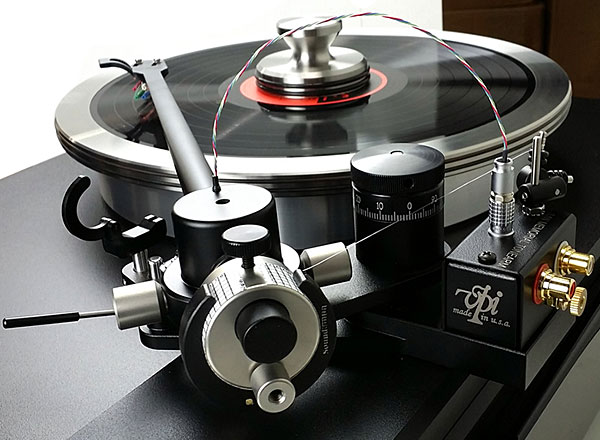
Rotating the JMW's asymmetrically weighted ring set the azimuth by shifting greater mass to one side or the other. It was an ingenious idea, but the heavy counterweight suspended by an O-ring produced a mass/spring system much like that of a cartridge suspension/tonearm, the resonant frequency of which I'm not sure. But I am sure that it's probably best to avoid hanging a resonating mass/spring system from a tonearm housing.
In addition, the original JMW arm didn't include an antiskating mechanism. Harry Weisfeld believes that skating compensation creates more sonic problems than it solves. His original suggestion—to twist a unipivot's looped tonearm wire to produce an antiskating side force—is reasonable only if you also "don't believe" in correctly setting azimuth.
Some audiophiles were made uncomfortable by the JMW Memorial's shaky, unstable behavior as it was lowered onto the record, but that, in my opinion, was a problem more of appearance than of performance. All pure unipivot tonearms do this, including the Immedia RPM, its designer's new Spiral Groove Centroid, and the Kuzma Stogi S. And grizzled vinyl veterans will remember the old Magnepan unipivot, which wobbled the same way.
Over the years, refinements have resulted in a JMW Memorial Arm vastly improved in mechanics and sound. The azimuth ring/stabilizer and O-ring gave way to an Immedia RPM2–like flared bearing housing and Graham 2.2–like stabilizing side weights, the latter affixed to the sides of the bearing housing. Azimuth is now set by rotating an asymmetrically hung counterweight. The inconvenient truth of this arrangement is that when you loosen the grub screw to adjust the azimuth, the couunterweight inevitably moves fore or aft, thus also changing the vertical tracking force (VTF). Weisfeld addresses this on some with a hex bolt threaded into the counterweight stub, to provide fine adjustment of VTF.
Most important, in my opinion, the JMW's cantilevered platform has been made far more massive and sturdy, and its shape changed to move the bearing closer to the VTA adjustment tower. Once you've set VTA and SRA, a rubber-tipped cylinder at the platform's unsupported end can be lowered to contact the plinth below, to form a rigid support system for the arm.
The bearing itself, and the jeweled cup within the bearing housing, have also been considerably improved. And an antiskating mechanism is now an option, though Weisfeld continues to believe that it produces negative sonic effects. The JMW Memorial arm now costs $1200 for the 9" version, $3000 for the 12" version.
A 3D-printed tonearm
Last year, VPI introduced a 3D-printed version of the 12" JMW Memorial Arm: the armtube is now a single piece of plastic resin joint-free from headshell to counterweight stub. Some tonearm designers maintain that a jointed armtube can be superior because, among other reasons, each joint acts as a damping barrier that inhibits the production of a unified, tuned vibrational mode. The proof, of course, is in the listening.
The JMW Classic 3D tonearm's most immediately obvious sonic characteristic was a smooth, non-resonant, exceptionally well-balanced tonal quality that makes it almost seem to disappear. Its sonic transparency most reminds me of the Continuum Cobra, another "one-piece" arm that uses a different construction technique to achieve a similar result.
Harry Weisfeld also sent along the standard 12" JMW Memorial Arm, which I also set up with the Lyra Atlas cartridge, so I could make direct comparisons. There was no comparison. By the time you read this, I'll have posted on AnalogPlanet.com files of needle drops made using both arms—you can compare them for yourself. You can find the blind listening test results here.
It's not that the metal JMW arm is so bad—it's that the 3D-printed version is so good. On the other hand, it made obvious to me that, even though the more expensive Kuzma 4Point, too, is made of metal, it sounds better than the metal JMW Memorial. Had the Classic Direct been supplied with the metal arm, I think I'd have asked to be sent an armboard cut for the Kuzma 4Point, just to be sure that what I was hearing was the arm and not the 'table.
If you own a JMW Memorial Arm, your next upgrade—even before you replace your cartridge—should be the 12" 3D armtube. Otherwise, you really won't know your cartridge's true capabilities. In addition, I highly recommend the Soundsmith accessory for setting azimuth and fine-tuning VTF that Weisfeld included with the arm. It comes with a self-stick grid you apply to the counterweight, and a semicircular, asymmetrically weighted plastic ring that snaps on to the counterweight. Sliding the ring fore and aft on the counterweight fine-tunes the VTF; rotating the ring on the counterweight adjusts the azimuth. The grid provides a handy reference for positioning the ring to adjust azimuth without changing the VTF.
Quibbles
You don't properly set VTA and SRA by placing the tonearm parallel to the record surface, and you definitely don't set azimuth by placing a rod atop the headshell and adjusting the angle until the distance from the rod to the record surface is equal on both sides of the cartridge! And please remember that, while 12" arms have a theoretical advantage of lower tracking error, a 12" arm's greater length from pivot to stylus will magnify any error in setting the cartridge overhang and/or zenith angle.
Summing Up
My advice: Go crazy in setting up your cartridge in the 3D-printed JMW Memorial. If you do, you'll go crazy—in a good way!—with your first listening session. I did, and with every session thereafter.
- Log in or register to post comments


